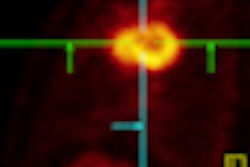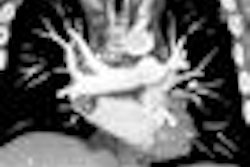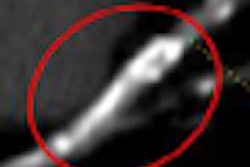VIENNA - A first peek at the first results of the first large randomized lung cancer screening trial to near completion found that CT detected four-fifths of participants' lung cancers at stage I -- in time to effect a curative resection.
Baseline screening results of the Nederlands-Leuvens Longkanker Screenings Onderzoek (NELSON) trial, unveiled in a special focus session at the 2009 European Congress of Radiology (ECR), are in line with those of the International Early Lung Cancer Action Program (I-ELCAP) and other nonrandomized studies.
At a minimum, they show that low-dose MDCT screening of a high-risk population is as effective in finding early-stage disease in a large European cohort of smokers and former smokers as it is in the U.S.
Early results of the study initiated in 2004 also provide important new information about the type, shape, location, and growth rate of lesions that turn out to be malignant. Nevertheless, the answer to the central question of the trial -- whether CT screening saves lives compared to no screening -- will have to wait at least another year.
Results of the only other large randomized lung cancer screening study in progress, the U.S.-based National Lung Screening Trial (NLST), are also expected in 2010.
Methods
"The NELSON trial was conducted in four centers, all using the same technology and the same postprocessing, starting with 16-detector MDCT systems," said investigator Dr. Matthijs Oudkerk, Ph.D., from the University Medical Center Groningen in the Netherlands. "One of the major drawbacks of screening is the high percentage of people who get further workup with all kinds of diagnosis, and this trial is completely focused on just volumetry" of detected nodules.
The nodule management is the first to be based on volumetry and is designed for a large population-based screening program without the standard use of fine-needle aspiration.
Dr. Dong Ming Xu, along with Oudkerk and colleagues, sought to determine whether MDCT screening for lung cancer in smokers and former smokers using MDCT 16-detector-row scanners (Mx8000 IDT or Brilliance 16P, Philips Healthcare, Andover, MA; Sensation 16, Siemens Healthcare, Erlangen, Germany) at 0.75-mm collimation and 15-mm table feed per rotation (pitch, 1.5) in years one, two, and four (still in progress) would lead to a reduction in lung cancer mortality of at least 25% compared to an unscreened control group.
Images were acquired in a breath-hold after inspiration to minimize motion artifacts, Oudkerk said. The noncontrast, low-dose protocol depended on body weight, using 80-90 and 120-140 kV and variable mAs to achieve CT dose index volume (CTDIvol) radiation dose of 0.8, 1.6, and 3.2 mGy for subjects weighing less than 50 kg, 50-80 kg, and more than 80 kg.
The control group, matched to the screening cohort, received sputum screening and DNA blood analysis at the beginning of the study but did not undergo CT screening.
The participants consisted of 55% smokers and 44% former smokers, with a smoking history of almost 30 years. Mean age was 57 years (16.4% women).
Noncalcified nodules were classified into four categories based on size or growth, with 1 being nonsignificantly small, 3 as indeterminate (50-500 mm3), and 4 as potentially malignant (> 500 mm3) and referred for workup diagnosis. Nodules smaller than 50 mm3 (approximately 5 mm in diameter) were considered negative and relegated to annual follow-up.
For solid nodules and for the solid component of partial solid nodules, volume was calculated by 3D volumetric computer assessment, which the radiologist was able to override in case the assessment was not considered accurate. Diameter measurements were used for pleural-based nodules.
Subjects with indeterminate results at baseline were rescanned in three to four months to assess growth. If there was no growth, they were returned to annual screening. Conversely, histological diagnosis was obtained for nodules showing significant growth at follow-up, Oudkerk explained.
"When there was a volume change of less than 25% in diameter ... it was regarded as no growth; more than a 25% volume increase was regarded as growth," Oudkerk said. At incidence screening, volume doubling time (VDT) of less than 400 days was referred for workup, and VDT of 400-600 days was considered indeterminate and returned to annual screening, as were slow-growing nodules with VDT of more than 600 days.
During incidence screening, the negative, positive, or indeterminate test result was based on the largest nodule or the one with the fastest growth. Individuals with negative results by this measure were rescheduled for year four.
Of 30,000 eligible respondents, nearly 16,000 people were randomized to screening or no screening, Oudkerk said. In all, 7,557 were scanned at baseline and a high percentage (n = 7,289) returned for the second round of scans.
According to the results of the first round of scanning, screening detected 1,395 benign calcified nodules and 7,298 noncalcified nodules, of which 4,861 nodules were regarded as negative (volume < 50 mm3), Oudkerk reported. Of these 2,101 (29%) nodules were solid and 57 (0.7%) were part-solid and considered indeterminate. Seventy-eight (1.1%) were nonsolid and regarded as indeterminate with a volume of 50-500 mm3.
Of the noncalcified nodules larger than 500 mm3, 126 (1.7%) were solid and five (0.7%) were part-solid, Oudkerk said. From the indeterminate nodules with a VDT of less than 400 days, 70 lung cancers were diagnosed after one year and another 54 cases in the follow-up screening rounds.
Compared to the advanced stage typically found at lung cancer diagnosis, "we had a remarkable shift in stage," Oudkerk said. "The percentage with stage I was almost 80%, so that's very promising."
Additional results in Radiology
Oudkerk also described additional study results recently published in Radiology (January 2009, Vol. 250:1, pp. 264-272) showing the characteristics of the nodules that were followed in the study.
"We found that nonspherical nodules had the largest volumes at detection, and, furthermore, that when the margins were speculated they became the largest volumes," he said. "Spherical and smooth [nodules] had the longest volume doubling times -- a little different than we thought it would be. ... Very regular growth, smooth and spherical, tends to be benign," a positive finding because so many nodules fit these criteria, Oudkerk said.
In all, 86% (767/891) of detected nodules were categorized as spherical, and 14% (124/891) were nonspherical; 73% (654/891) were smooth, 19% (168/891) were lobulated, and 8% (69/891) were spiculated or irregular in shape, the authors reported in Radiology. Nearly half (46%, 412/891) of the nodules were purely intraparenchymal, and 54% (479/891) were attached.
"In smooth or attached nodules, no malignancies were found, despite the fact that some of them showed indeterminate or even high growth rates during a one-year follow-up period," they noted. "In contrast, all cancers originated from purely intraparenchymal nodules."
None of the smooth nodules in the study were malignant. However, 14.5% (10/69) of the spiculated or irregular nodules and 3.6% (6/168) of the lobulated nodules were found to be malignant. All cancers were purely intraparenchymal, and no cancer cases originated from attached nodules.
Nonspherical nodules were more frequently purely intraparenchymal than expected, whereas spherical nodules were more often juxtavascular, fissure-attached, or pleural-based (p < 0.0001).
Smooth or attached indeterminate noncalcified nodules comprised 83% (743/891) of all indeterminate solid pulmonary nodules detected and are a very common finding, the authors wrote. "On the basis of these observations, we recommend that in this type of indeterminate nodule detected at baseline screening, one-year follow-up CT scanning is sufficient, without additional repeat scanning at three or six months."
On the other hand, univariate logistic regression analyses showed that nonspherical morphology, lobulated or spiculated margins, purely intraparenchymal location, and a larger baseline volume were all significantly related to the presence of lung cancer.
Conclusions
"None of the detections of juxtavascular, fissure-attached, or pleural-based nodules had a volume doubling time of less than 400 days, which is remarkable," Oudkerk said, "so morphology and localization can tell you something about the chance that there will be malignant growth."
VDT of less than 400 days at follow-up in 891 nodules was significantly related to the presence of lung cancer, with a positive predictive value of 63%, he said.
"Volume doubling time increases in significance after one year; the hazard ratio goes up to 867, which means a 50% chance of malignancy," Oudkerk said. "So volume doubling time has become an extremely powerful tool. More important is that at the one-year follow-up there was one interval carcinoma, and at the two-year follow-up we just had three interval cancers, so there really is a hope that this is a workable screening scheme."
In smooth and solid indeterminate pulmonary nodules, or a nodule attached to a fissure, pleura, or vessel, cancer risk is absent in this study after a year follow-up, Oudkerk said.
"In nonsmooth, purely intraparenchymal noncalcified nodules, volume is the only predictor for malignancy at baseline screening," he said. "A volume doubling time of less than 400 days at one-year follow-up has a positive predictive value of 63% for malignancy in solid indeterminate pulmonary nodules, which is of course very high. Smooth or attached to a fissure, pleura, or vessel, solid indeterminate pulmonary nodules require no shorter follow-up than one year."
For nodule management based on low-dose CT and 3D volume assessment, no additional workup is required in lung cancer screening, Oudkerk said.
By Eric Barnes
AuntMinnie.com staff writer
March 9, 2009
Related Reading
CT screening catches small cell lung cancers earlier February 10, 2009
Interobserver variability generally low at lung screening follow-up, January 28, 2009
New CT method measures airway calcium to predict lung cancer, December 16, 2008
Lung CAD holds up well in low-dose MDCT studies, November 25, 2008
CT lung cancer screening reduces mortality, October 26, 2006
Copyright © 2009 AuntMinnie.com



















